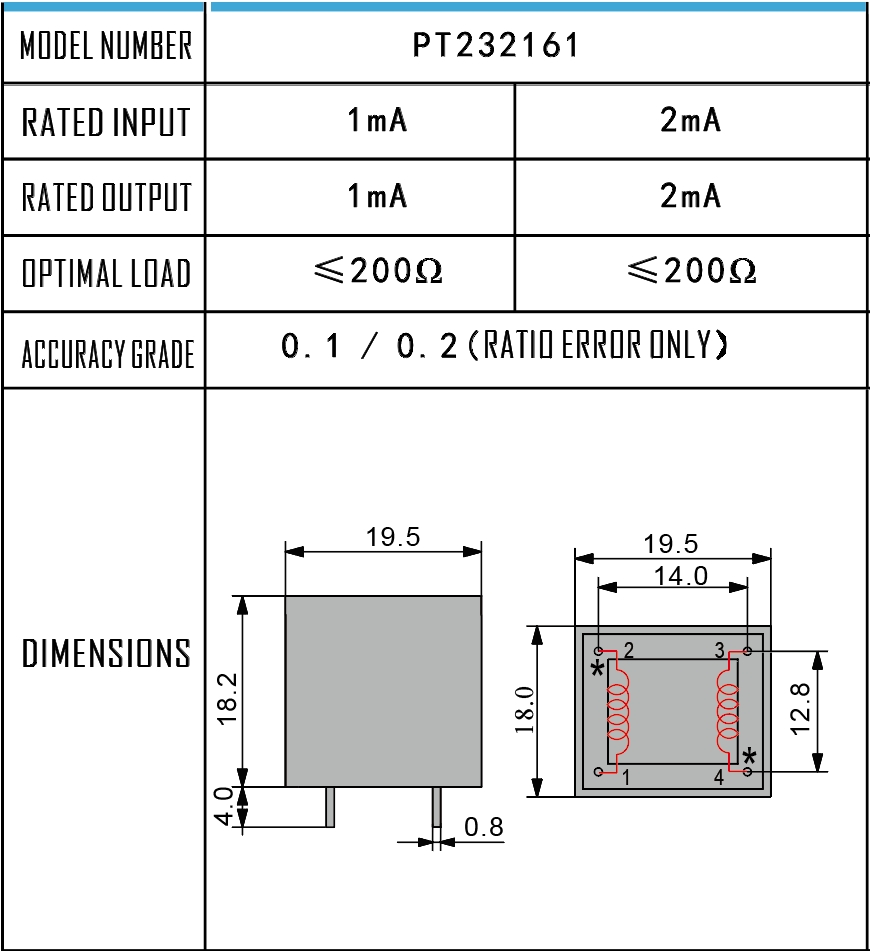
Product Center
Micro Precision Transformers
Current Type Potential Transformers
The micro precision voltage transformer can accurately convert the voltage of the measured circuit into the input voltage required by the instrument. There are two main categories of products: current input voltage transformer and voltage input voltage transformer.
The application principle of the current input voltage transformer is: first convert the primary voltage to be converted into a 1-6mA current through a current limiting resistor and input it to the primary end of the voltage transformer. The primary and secondary turns of the voltage transformer are equal, and a resistor is connected in parallel to the secondary of the transformer, and then the weak current of the secondary is converted into a voltage signal output. The schematic diagram is as follows:

The current-type voltage transformer can reduce the size of the device as much as possible, which is conducive to the miniaturization of the instrument. However, the current-type voltage transformer requires a current-limiting resistor, and its stability directly affects the conversion accuracy of the transformer; especially when the measured voltage level is high, it is more important to pay attention to the dissipated power of the current-limiting resistor must meet the design requirements, and also pay attention to its heat dissipation conditions. At the same time, the secondary load capacity of the transformer is poor, and the general output voltage is not greater than 1V. Excessive output voltage will reduce the dynamic range and linear accuracy of the transformer. In terms of secondary signal processing, a smaller load resistor can be used in conjunction with a precision rectifier amplifier circuit. It can not only ensure the conversion accuracy, but also ensure the secondary sampling accuracy, and also reduce the dissipated power of the current-limiting resistor, which is conducive to reducing costs and improving the reliability of the circuit. The application circuit can refer to the following circuit, or it can be transformed according to other precision rectifier circuits.

The figure above is the most classic combination of current-type voltage transformer and precision rectifier circuit. The required voltage can be obtained by selecting the value of RL and adjusting the resistance value of R5; the resistance matching relationship is R1=R2, R4=R5=2R3; and a filter capacitor can be connected in parallel to resistor R5. The resistance value of R6 is determined by Vin/Iin, and the rated dissipation power can be selected to be twice Vin*Iin or greater.
The voltage input type voltage transformer has the same principle as the conventional transformer. It mainly focuses on the conversion accuracy. The measured voltage is directly output to the primary output end of the voltage transformer, and the secondary directly outputs the voltage. The output voltage of the secondary can be flexibly set according to the needs. Generally, it is between 1V-10V. The voltage transformer mainly uses high-quality annular oriented silicon steel core, which has high precision and good linearity.
Both types of voltage transformers have their own advantages. If you focus on conversion accuracy, stability and reliability, you should choose a direct input voltage transformer; if you focus on conversion accuracy, require a small size and good heat dissipation conditions, you can choose a current type voltage transformer.
High-voltage voltage transformer products can be customized, the primary input voltage can reach 3000-10000V, the secondary output voltage is 0-100V, and the isolation withstand voltage can reach 20KV-42KV, which fully meets the medium and high voltage measurement range.
key features:
*High precision, accuracy can be better than 0.1%
*Good linearity, linearity can be better than 0.1%
*Small size, compact structure, small space occupation
*Asymmetric design of PCB pin leads to improve production efficiency.
*Good consistency, optimized production process, ensuring consistency of products in the same batch and consistency of products in different batches
*Epoxy resin encapsulation process, excellent insulation performance and moisture resistance
Basic electrical parameters:
Operating frequency: 50Hz-400Hz
Operating temperature: -25c - +75c,
Dielectric strength: 2500V/min.
Insulation resistance: 1000M Ohms @ 500 Vdc
Impact voltage: 5000V (1.2/50µs standard lightning wave)
Accuracy level: in accordance with IEC 60044-1 current transformer 0.1, 0.2 level
Flame retardant level: UL 94-V0
Naming:


Add:Sanqing Century Wealth Center, Tianchen Road, Lixia District, Jinan City
Email:export@bojingchina.com
Fax:0531-85708558
Copyright © 2024 Shandong Bojing Intelligent Technology Co., Ltd. All Rights Reserved.
鲁ICP备19065564号-1















